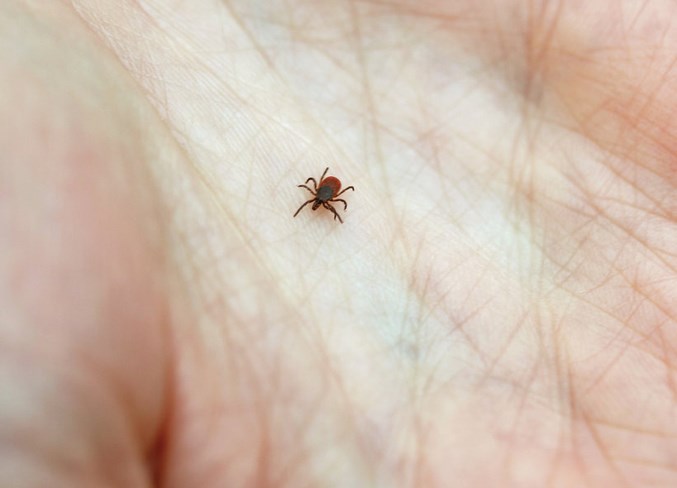Just like anything, there are tricks when it comes to ticks.
"There's always options for prevention," said Dr. Gerhard Benade, AHS medical officer of health for the north zone.
But one thing to keep in mind, is that although an area may be tick free one day, that could quickly change.
“The important thing to know about ticks, is they move around on other animals. Wherever you have animal activity, whether it’s land-based or even birds, in an area that’s tick-free now might have ticks days or weeks later, depending on the traffic in that area,” Benade detailed.
There are ways of avoiding being bitten by the arachnid.
Keeping your lawn well manicured, and taking extra steps to ensure wildlife stays off of your property are some options for around the home.
Wearing long sleeves and pants when hiking or walking through tall grass is one way, and it never hurts to add insect repellents containing DEET into the mix.
“After going into areas like these, check yourself, because the sooner you find the tick the easier it is to avoid things like Lyme disease and so forth,” explained Benade, adding it's also important to check kids and pets.
According to Judith Rodriguez, executive director of the Bonnyville SPCA, ticks prefer areas with thin skin. She encourages giving a thorough search of your pets ears, stomach, and underarms.
“The moment you find a tick, which will hopefully be shortly after you’ve been to an area where there may have been ticks and you check yourself, then you want to remove it as quickly as possible," said Benade.
Removing a tick can be done at home, by a family physician, or a vet.
Benade said it's important that when spotting a tick to remain calm.
“What you want to avoid is breaking the tick or disconnecting its head from the body,” he noted.
To do this, you have to use tweezers to grasp a tick by the head and gently pull until it lets go.
Although there isn't an instant risk of Lyme disease like some may believe, the longer a tick is on you, the higher the risk.
“The skin break would probably not put you at risk of Lyme disease, but certainly when the ticks is broken, the head has become disconnected, or it’s been attached for a long time, the risk for Lyme disease goes up,” Bonade said. “The thinking is generally, if you remove the tick within the first 24 hours, the risk for Lyme disease is greatly reduced."
Even pets are at risk of Lyme disease, but what pet owners may not know Rodriguez said, is ticks can also carry parasites or bacteria that can be passed on to a dog or person.
This is one of the reasons why Benade stresses checking yourself and your loved ones anytime you have been in an area that could be home to ticks.
This creepy crawler isn't new to the area. In fact, Benade claims there have always been ticks because of the high traffic of moose, deer, and other wildlife.
"We also have a lot of bird migration," he added, which could be what brings in the Lyme-disease infected ticks.
Lyme disease has three phases.
The early stage causes a rash, fever, aches ,and pains.
Benade described it as almost a "flu-like illness."
These symptoms can show-up within a week of being bitten, but can take longer.
“If the individual isn’t treated, then usually within three months or so, a more systemic illness can develop, which can effect the heart, nervous system, causing headaches, muscle weakness, inflammation of the eyes, and so forth,” Benade described.
The final stage is when the illness becomes chronic and can cause significant nerve or cardiac damage.
There are treatments for Lyme disease, which vary depending on a person's allergies or healthcare professional.
“It kind of depends on the stage you’re in and the severity of it,” added Benade.
In order to keep track of where ticks are coming from, and whether or not they're infected with Lyme disease, Alberta Health is asking anyone who finds one on themselves, on others, or on their pets to submit them for analysis.
In Bonnyville, a tick found on a human can be handed in to the Bonnyville Health Centre. If a tick is found on a pet, the a trip to the vet is the best option.
The program has been in place since 2007, and has managed to give the province a better idea of the types of ticks that are being found across Alberta.
"Thanks to Albertans who have submitted ticks, the government has been able to monitor what types of ticks that are in the province. Although the risk of getting Lyme disease in Alberta is very low, I encourage Albertans to keep submitting ticks they find so we can continue to assess this risk," said deputy medical officer of health Dr. Kristin Klein in a release.
The number of Lyme disease cases in Alberta have increased over the years, with the highest point reaching 19 confirmed cases.
In 2016, there were only 10.
Benade said, “I want people to enjoy summer. Prevention is better than a cure; check yourself, your children, and your pets. If you find a tick right away, don’t panic."



